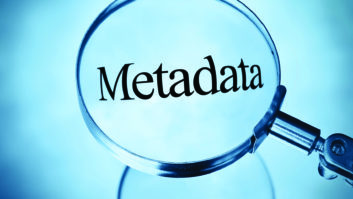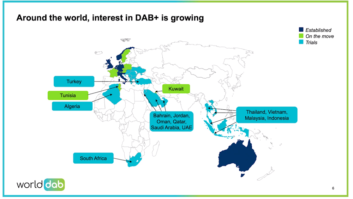Some 25 years since its development and nearly a decade since its first real service introductions, DAB is still experiencing a roller-coaster deployment.
Developed in Europe during the 1980s as the Eureka-147/DAB format, it was placed into initial service in the mid- and late 1990s in several (mostly European) countries with much excitement. Since then, the only place where it has achieved widespread adoption by consumers is in the U.K., starting in the early 2000s.
The U.K. experience with DAB has been unique for several reasons. Primary among them has been the broad availability of inexpensive receivers there, plus the introduction of numerous DAB broadcast channels that are largely non-duplicative of content available simultaneously over AM, FM, satellite or Internet radio.
The success of DAB under these conditions (over 6 million receivers sold in the U.K. to date) has shown how the combining of new, well-promoted, digital-only services with cheap, widely available receivers can drive consumer uptake. Compare this with other markets in which DAB has been positioned as an “analog replacement” service (meaning it carries only simulcasts of AM and FM stations).
A good example of the latter is Canada, where DAB now is widely considered a failure.
(click thumbnail)Credit: Stacy Braswell/stock.xchngRecent U.K. setbacks
But all is not well of late in DAB’s promised land.
Recent U.K. activity indicates that even in such a fertile environment, the successful launch of digital radio remains difficult. Starting late last year, a series of circumstances have indicated that DAB’s apparent buoyancy in the United Kingdom may be fleeting.
The process is worth noting for the general lessons it can provide in the ongoing deployment of IBOC, or for that matter, any prospective successors to existing broadcast formats. Let’s recount these recent snags:
First, the cost of providing DAB services — particularly those carrying exclusive, DAB-only content — is apparently becoming prohibitive for some U.K. broadcasters.
While the BBC has persevered with its several DAB-only services (along with DAB duplication of its popular analog radio services), several commercial broadcasters recently have dropped or curtailed some of their DAB-only channels, and additional similar cuts may be forthcoming. A few of these services had been in place for some eight or nine years, so this does not appear to be a frivolous decision, but rather a more considered, strategic move.
Coincidentally, however, Ofcom, the U.K. telecom regulator, has arranged for more spectrum to be made available for DAB services across the U.K., with a new national commercial multiplex launching later this year.
So just as the existing DAB spectrum is losing services, new spectrum is being added — a double whammy devaluation. This could cause the bottom to drop out of the DAB service market, and while this might allow some new, marginal broadcasters to enter the space, it likely won’t retain the major players (who are increasingly concerned with CPM), and the end result could be an overall loss of DAB listenership, with a significant dampening of momentum in consumer receiver deployment.
And speaking of receivers, while there has been a proliferation of tabletop and portable DAB designs, there is an almost complete lack of DAB car radios in the U.K. Although radio listening in the car is not quite as prevalent there as it is in the United States, this is still a significant failing of the format to date. It persists in the U.K. several years after DAB designs have been outselling analog radios in other form factors.
This is because most European car manufacturers will not develop new systems until there is a broad, pan-European call for them. Since DAB has only become popular in the U.K., and not yet in the remainder of the continent, there are few DAB radios in the cars there. (To date, factory-installed DAB receivers are only available as an option on a very few high-end German vehicles.)
Remember also that because DAB operates in Europe in either the upper VHF band or L band, a DAB tuner requires its own antenna system, separate from the AM and FM aerials, making its automotive application far more complex and costly than mobile analog (or IBOC) radios.
For this reason, aftermarket mobile DAB radios also have not proliferated in the U.K. Thus the format’s excellent mobile performance notwithstanding, it has remained largely a fixed or portable service, even in its most popular environment.
This clearly is a lost opportunity for greater penetration of the format in the U.K., but the market appears unable to garner the critical mass required to move the European automotive radio market toward widespread adoption of DAB.
Another concern voiced in the U.K. regards the current audio quality of DAB there. Because the DAB format uses an older audio codec — MPEG-1 Audio Layer 2, or “MP2” — it is not as bandwidth-efficient as more recently developed systems. The DAB transmission format is quite fungible, however, allowing a range of bit rates to be used to squeeze as many audio and/or data channels as are desired (and practical) into the 1.5 MHz occupied by each RF “ensemble” or multiplex.
This is but one of many examples of the digital conundrum pitting quality vs. quantity, similar to the decisions U.S. broadcasters grapple with over IBOC multicasting.
Pressure to make DAB more appealing to listeners has caused U.K. broadcasters to drop audio bit rates to accommodate more services. Unfortunately, the MP2 codec doesn’t sound very good below about 192 kbps for stereo, and when some broadcasters dropped down to 160 kbps or lower on some services, many listeners complained.
(Remember most of the audience is listening on headphones or on a tabletop radio in a quiet home, so artifacts may be fairly noticeable — especially if you’ve gotten used to hearing a service in high fidelity and suddenly things change.)
Compare this to more recent codecs that perform well at 96 kbps or less, as used in IBOC and other digital audio services.
One attempt to resolve the problem in the U.K. was to run some DAB services in mono, which only begged the question of why many of these same channels were concurrently available in stereo on analog FM.
Finally, another recent pullback also reflected on DAB’s U.K. fortunes, when the deep-pocketed British Telecom fairly abruptly pulled the plug on its Movio service after hardly a year of full operation.
Movio had provided mobile TV service over DAB, using a recently standardized enhanced format (a system called DAB-IP, which increased error correction in a backward-compatible manner for robust delivery of IP packets containing video and audio; see the Sept. 12 and Sept. 26, 2007 editions of this column at radioworld.com for more on this).
This service took up a fair amount of national DAB bandwidth, and when it finally ceases broadcasting later this year, excess DAB spectrum will be even more plentiful, perhaps further devaluing it.
Not dead yet
Of course, the U.K. DAB story is far from over.
The changing economics of the transmission space there may attract new players that turn things around yet again. Meanwhile, the stewards of the DAB format have been busy trying to update their standards to remain viable.
The recently approved DAB+ format includes a new codec (HE-AAC), spectrally efficient surround-sound capability (MPEG Surround) and increased error correction, but these improvements are not backward-compatible and require new receivers, which are not yet available.
DAB+ may be useful in attracting countries where digital radio service has not yet been established (or even places where DAB has failed to flourish), however.
Another application that can ride on DAB’s COFDM RF layer is Digital Multimedia Broadcasting (DMB), first developed in Korea, and now trying hard to move into other environments.
It allows mobile TV and other multimedia content to be distributed to DMB-capable receivers over the original DAB transmission architecture. Hopes are so high for this format to revitalize DAB that its standards body, formerly known as the WorldDAB Forum, has changed its name to WorldDMB.
On the other hand, competing formats for digital radio from Digital Radio Mondiale (DRM and DRM+) and even a fledgling European IBOC movement, along with mobile TV/multimedia competition from DVB-H (a handheld version of the highly successful European DTV format DVB-T) will keep things interesting for DAB as it struggles for continued relevance. Some preferences for these other systems have been shown by broadcasters and regulators alike across the European Union of late.
In the UK, Ofcom has tried to up the ante by offering longer terms on FM licenses if a broadcaster agrees to also provide DAB service. Of course, this seems in conflict with the simultaneously held regulatory premise that DAB is the replacement radio format of the future, but such is the peril that DAB seems to face in the short term there.
Interestingly, two audience segments that have strongly engaged with DAB in the U.K. are the geriatric and special needs communities.
Apparently the simplicity and low cost of DAB tabletop receivers appeal to these listeners, for whom Internet and WiFi are often not a workable option. While a commendable result, this is hardly a ringing endorsement toward a “format of the future.”
Waiting on the world to change
Clearly there is much for U.S. broadcasters to learn from the ongoing DAB experience in the U.K., where tightening economic conditions coupled with gradually expiring patience of broadcasters have turned what looked like a clear success story into a mixed picture. Whether this is a brief stumble or the start of a long downward trend for U.K. DAB remains to be seen.
Differences between the U.S. and U.K. systems also are highlighted by this analysis. For example, the U.S. has no portable IBOC yet, and the U.K. has no mobile DAB to date. Conversion and ongoing operational costs are also somewhat different, as are the regulatory, commercial vs. noncommercial, and national vs. local contexts.
Thus the use of the U.K. experience as a bellwether for U.S. digital radio prospects requires significant filtering and a nuanced analysis. Nevertheless, a primary lesson to be learned is that the introduction of enhanced (let alone replacement) services for radio broadcasting is a tricky business, and one that will take a long time to run its course.













